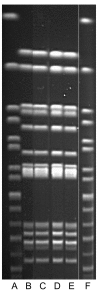Multidrug-resistant Salmonella Typhimurium in four animal facilities
- PMID: 16102313
- PMCID: PMC3320505
- DOI: 10.3201/eid1108.050111
Multidrug-resistant Salmonella Typhimurium in four animal facilities
Abstract
In 1999 and 2000, 3 state health departments reported 4 outbreaks of gastrointestinal illness due to Salmonella enterica serotype Typhimurium in employees, clients, and client animals from 3 companion animal veterinary clinics and 1 animal shelter. More than 45 persons and companion animals became ill. Four independent investigations resulted in the testing of 19 human samples and >200 animal samples; 18 persons and 36 animals were culture-positive for S. Typhimurium. One outbreak was due to multidrug-resistant S. Typhimurium R-type ACKSSuT, while the other 3 were due to multidrug-resistant S. Typhimurium R-type ACSSuT DT104. This report documents nosocomial transmission of S. Typhimurium and demonstrates that companion animal facilities may serve as foci of transmission for salmonellae between animals and humans if adequate precautions are not followed.
Figures



References
-
- Centers for Disease Control and Prevention. Reptile-associated salmonellosis—selected states, 1996–1998. MMWR Morb Mortal Wkly Rep. 1999;48:1009–13. - PubMed
Publication types
MeSH terms
LinkOut - more resources
Full Text Sources
Other Literature Sources
Medical
